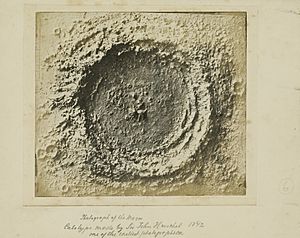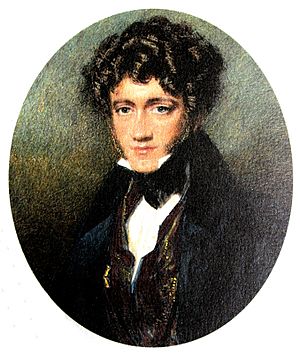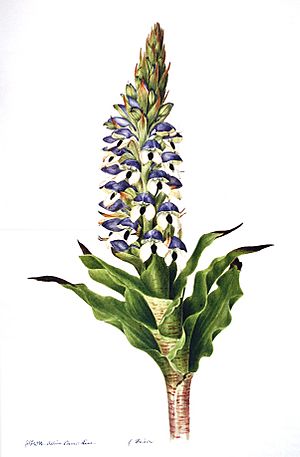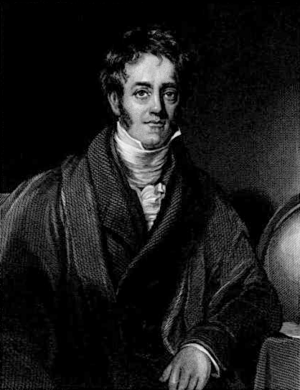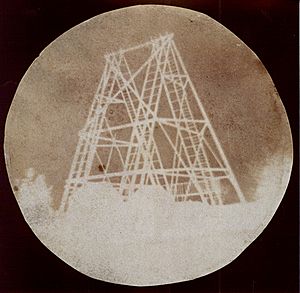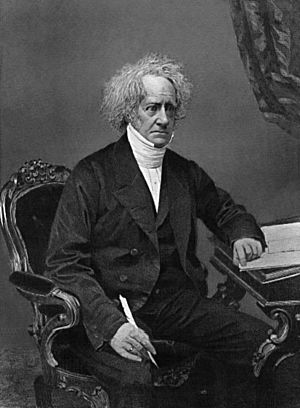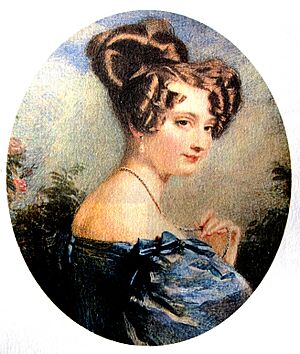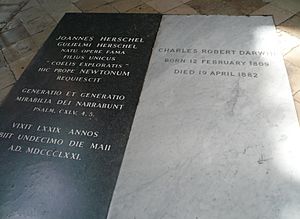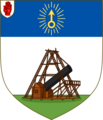John Herschel facts for kids
Quick facts for kids
John Herschel
|
|
|---|---|
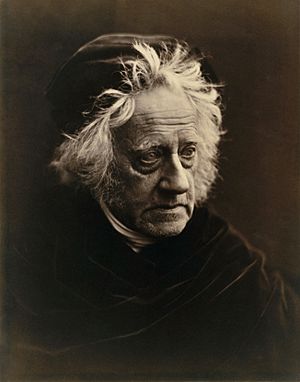
1867 photograph by Julia Margaret Cameron
|
|
| Born |
John Frederick William Herschel
7 March 1792 Slough, Buckinghamshire, England
|
| Died | 11 May 1871 (aged 79) Collingwood, near Hawkhurst, Kent, England
|
| Resting place | Westminster Abbey |
| Nationality | British |
| Education | Eton College |
| Alma mater | St John's College, Cambridge |
| Known for | The invention of photography |
| Awards |
|
| Scientific career | |
| Influences | William Herschel (father) Caroline Herschel (aunt) |
Sir John Frederick William Herschel (born March 7, 1792 – died May 11, 1871) was a brilliant English scientist. He was known as a polymath, which means he was an expert in many different subjects. John Herschel was a skilled mathematician, astronomer, chemist, and inventor. He also worked as a photographer and studied plants.
Herschel helped create the Julian day system, which astronomers use to keep track of dates. He gave names to seven moons of Saturn and four moons of Uranus. Uranus was a planet discovered by his father, Sir William Herschel. John Herschel also made many important discoveries in photography. He studied color blindness and how ultraviolet light affects chemicals.
In 1831, he wrote an important book called Preliminary Discourse. In this book, he talked about using an inductive approach to science. This means you observe things first, then form theories based on what you see. His ideas greatly influenced how science was done.
Contents
Early Life and Stargazing
John Herschel was born in Slough, England. His parents were Mary Baldwin and the famous astronomer William Herschel. His aunt, Caroline Herschel, was also a well-known astronomer. John went to Eton College and St John's College, Cambridge. He finished his studies at Cambridge in 1813 as the top math student.
While at Cambridge, he became good friends with other mathematicians like Charles Babbage and George Peacock. In 1816, he left Cambridge and began working with his father. He started his own astronomy work that same year. He built a special reflecting telescope with a large mirror.
Between 1821 and 1823, he worked with James South to re-examine double stars. These were stars that his father had cataloged. John Herschel also helped start the Royal Astronomical Society in 1820. He won the Gold Medal of the Royal Astronomical Society twice for his work. He also received the Lalande Medal and the Copley Medal for his math contributions. In 1831, he was made a Knight.
Herschel was the president of the Royal Astronomical Society three times. He held this position from 1827–1829, 1839–1841, and 1847–1849.
His book, A preliminary discourse on the study of natural philosophy, was published in 1831. It explained how to do scientific research. He said that nature follows laws that are hard to find. The main goal of science was to understand these laws. He believed in finding one simple explanation for things. This book was very important and inspired many scientists. One student, Charles Darwin, was especially inspired by it.
In 1854, he became a member of the American Philosophical Society.
In 1864, Herschel published a huge book of his astronomy observations. It was called the General Catalogue of Nebulae and Clusters. This book combined his own work with his father's. Another book was published after he died. It listed 10,300 multiple and double stars.
Herschel also studied eye problems. He correctly thought that astigmatism was caused by an uneven cornea. He even suggested that vision could be improved by putting animal jelly in a glass capsule on the eye. He wrote about these ideas in 1828 and 1845.
Some of the galaxies Herschel discovered include NGC 7, NGC 10, NGC 25, and NGC 28.
Exploring the Southern Skies
John Herschel decided to travel to South Africa. He paid for his own trip and left England in November 1833. His wife, their three children, and his large telescope came with him.
The main reason for the trip was to study the stars and nebulae in the southern sky. He wanted to finish and add to the star maps his father had started. He arrived in Cape Town in January 1834. He set up his telescope at a place called Feldhausen, near Cape Town. While there, he also saw Halley's Comet return.
Herschel worked with Thomas Maclear, who was the Astronomer Royal at the Cape of Good Hope. Their families became very close friends. During his time in South Africa, he also saw a huge eruption of the star Eta Carinae.
Being in South Africa also gave Herschel a break from his busy life in London. He was one of the most popular scientists in Britain. In South Africa, he could do many different scientific projects without feeling pressured. He later said it was one of the happiest times of his life.
John and his wife, Margaret, worked together on botanical illustrations. Between 1834 and 1838, they drew 131 beautiful pictures of plants from the Cape. John used a special tool called a camera lucida to get the plant outlines. Margaret then added all the details. These drawings were meant for their own records. But they were so accurate that they are still valuable today. Many of these drawings were published in a book called Flora Herscheliana in 1996.
The Herschels lived at 'Feldhausen' near Table Mountain. This is where John set up his telescope to map the southern skies.
Herschel also read a lot. He was very interested in Charles Lyell's ideas about how landscapes slowly change over time. He wrote to Lyell in 1836, praising his book. Herschel believed that new species appeared through a natural process, not a sudden miracle.
When HMS Beagle visited Cape Town, Robert FitzRoy and Charles Darwin met Herschel. Darwin was later influenced by Herschel's ideas. Darwin even mentioned Herschel in the first lines of his famous book, The Origin of Species. However, Herschel did not agree with Darwin's theory of natural selection in the end.
Herschel returned to England in 1838. He was given the title of baronet. In 1847, he published his book, Results of Astronomical Observations made at the Cape of Good Hope. In this book, he suggested the names for seven of Saturn's moons. These names are still used today: Mimas, Enceladus, Tethys, Dione, Rhea, Titan, and Iapetus. He won another Copley Medal for this work. In 1852, he also named four of Uranus's moons: Ariel, Umbriel, Titania, and Oberon. Today, a stone monument marks the spot where his telescope once stood in South Africa.
Inventing Photography
John Herschel made many important discoveries in photography. He improved how photos were made. He invented the cyanotype process, which is now known as blueprints. He also created other photo methods like the chrysotype. In 1839, he took a photograph on glass, which still exists. He even experimented with color photography. He noticed that different colors of light would make their own color appear on special paper.
Herschel also experimented with using plant juices to make photosensitive paper. These were called phytotypes or anthotypes. He published his findings in 1842. In the early 1840s, he worked with Henry Collen, a portrait painter for Queen Victoria. Herschel also discovered the platinum process for photography. This process uses light-sensitive platinum salts.
Herschel was the first person to use the word photography in 1839. He also came up with the terms negative and positive for photography.
In 1819, Herschel found that sodium thiosulfate could dissolve silver salts. He told Talbot and Daguerre about this discovery. This chemical, often called "hypo," could be used as a photographic fixer. It made pictures permanent so they wouldn't fade. He started using it for this purpose in early 1839.
Herschel's important research on photography was shared at the Royal Society in London in 1839 and 1840.
Other Cool Discoveries
Herschel wrote many articles and papers. He wrote about weather, geography, and telescopes for the Encyclopædia Britannica. He also translated the ancient Greek poem, the Iliad.
In 1823, Herschel published his findings on the colors of light from metal salts.
He invented the actinometer in 1825. This tool measured how much heat came directly from the Sun's rays. His work with this tool was very important for the early study of photochemistry.
Herschel even suggested a change to the Gregorian calendar. He wanted years that are multiples of 4000 to be normal years, not leap years. This would make the average year length closer to the actual time it takes for Earth to orbit the Sun. However, his idea was never used.
In 1832, Herschel became an honorary member of the American Academy of Arts and Sciences. In 1836, he joined the Royal Swedish Academy of Sciences.
In 1835, a newspaper in New York published a series of fake articles. They were called the Great Moon Hoax. These articles falsely claimed that Herschel had discovered animals living on the Moon, including bat-like humanoids.
Many places are named after him. These include the village of Herschel in Canada. A type of ancient sea reptile, a plesiosaur, was found there. Mount Herschel in Antarctica and the crater J. Herschel on the Moon are also named for him. In South Africa, there is a settlement called Herschel, Eastern Cape and the Herschel Girls' School.
Herschel Island in the Arctic Ocean is also named after the Herschel family. This includes John, his father William Herschel, and his aunt Caroline Herschel.
His Family
John Herschel married his cousin, Margaret Brodie Stewart, on March 3, 1829. They had many children:
- Caroline Emilia Mary Herschel (1830–1909)
- Isabella Herschel (1831–1893)
- Sir William James Herschel, 2nd Baronet (1833–1917)
- Margaret Louisa Herschel (1834–1861), who was a talented artist
- Prof. Alexander Stewart Herschel (1836–1907), a scientist
- Col. John Herschel (1837–1921), a surveyor
- Maria Sophia Herschel (1839–1929)
- Amelia Herschel (1841–1926)
- Julia Herschel (1842–1933)
- Matilda Rose Herschel (1844–1914), also a gifted artist
- Francisca Herschel (1846–1932)
- Constance Anne Herschel (1855–1939), a mathematician and scientist
His Legacy
John Herschel passed away on May 11, 1871, at his home in Kent. He was 79 years old. He received a national funeral and was buried in Westminster Abbey. His tomb is next to that of Charles Darwin.
Images for kids
See also
 In Spanish: John Herschel para niños
In Spanish: John Herschel para niños


